#Alexei Mikhailovich
Text

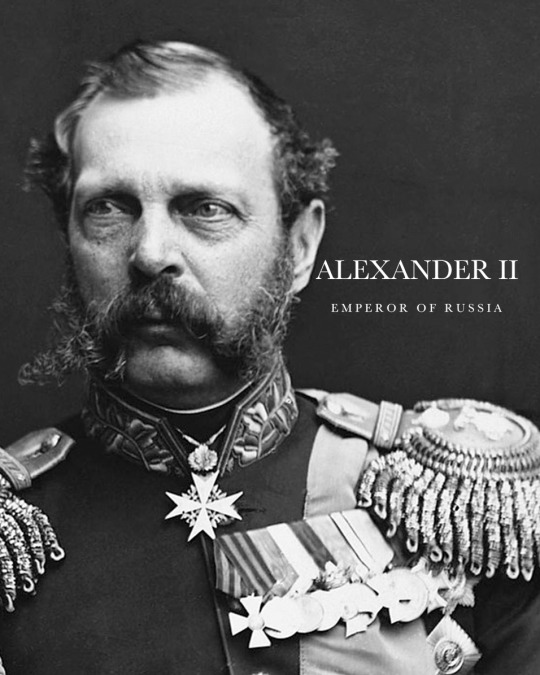

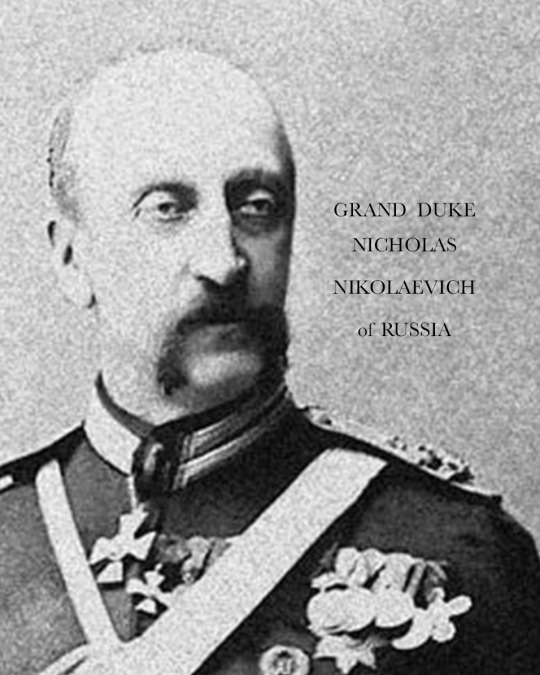

GODPARENTS OF GRAND DUKE ALEXEI MIKHAILOVICH
Grand Duke Alexei Mikhailovich was born on 28 December 1875 in Tbilisi, Tbilisi Governate, Russian Empire (now Georgia). He was the the sixth son and youngest child of Grand Duke Michael Nikolaevich of Russia, himself the youngest son of Emperor Nicholas I. He was the only Grand Duke to bear the name and patronymic of a Tsar: Alexei Mikhailovich. On 11 January (New Style) 1876, he was christened at Tbilisi by the Palace Priest and Confessor of Their Imperial Highnesses. He had seven godparents, as listed:
ALEXANDER II, EMPEROR OF RUSSIA - his uncle, the Russian Emperor stood as one of the godparents. He became the Emperor of All Russia in 1855. Alexander’s most significant reform as emperor was the emancipation of Russia’s serfs in 1861, for which he is known as Alexander the Liberator.
GRAND DUCHESS MARIA PAVLOVNA OF RUSSIA, GRAND DUCHESS CONSORT OF SAXE-WEIMAR-EISENACH - his aunt was one of his godparents. One of the daughters of Emperor Paul I, the grand duchess married a German prince Karl Friedrich, Grand Duke of Saxe-Weimar-Eisenach in 1804. She was an intellect, interested in both arts and sciences. German poet and novelist Johann Wolfgang von Goethe hailed her as one of the worthiest women of his time. She was the great-grandmother of Wilhelm II, German Emperor and Queen Victoria of Sweden.
GRAND DUKE NICHOLAS MIKHAILOVICH OF RUSSIA - his uncle, was one of his godparents. Trained for the military, as a Field Marshal he commanded the Russian army of the Danube in the Russo-Turkish War, 1877–1878.
GRAND DUCHESS MARIA PAVLOVNA OF RUSSIA - known as 'Maria Pavlovna the Elder', was the wife of his first cousin Grand Duke Vladimir Alexandrovich, and stood as one of his godparents. Born as Duchess Marie of Mecklenburg-Schwerin, her ancestors included Emperor Paul I of Russia. Upon her marriage to the grand duke, she became a prominent hostess in Saint Petersburg.
GRAND DUKE ALEXEI ALEXANDROVICH OF RUSSIA - his first cousin and namesake, one of the sons of Emperor Alexander II, was one of his godparents. Chosen for a naval career, Alexei Alexandrovich started his military training at an early age. By the age of 20 he had been appointed lieutenant of the Imperial Russian Navy, eventually becoming general-admiral.
GRAND DUCHESS ANASTASIA MIKHAILOVNA OF RUSSIA, GRAND DUCHESS OF MECKLENBURG-SCHWERIN - his sister, was one of his godparents. In 1879, when Alexei Mikhailovich was only four years-old, his only sister married a German prince, Friedrich Franz III of Mecklenburg-Schwerin (the elder brother of Grand Duchess Maria Pavlovna the Elder). Their children included Queen Alexandrine of Denmark and Crown Princess Cecile of Prussia. She was a strong-willed, independent and unconventional woman. She never became used to her new country where she was unpopular.
GRAND DUKE MICHAEL MIKHAILOVICH OF RUSSIA - one of his older brothers stood as another of his godparents. As Romanov tradition demanded, he followed a military career. He served in the Russo-Turkish War in 1877, became a Colonel and was adjutant at the Imperial court. In 1891 he contracted a morganatic marriage with Countess Sophie von Merenberg, a morganatic daughter of Prince Nicholas William of Nassau and a granddaughter of the Russian poet Alexander Pushkin. For contracting this marriage without permission, their first cousin Emperor Alexander III stripped him of his military titles and banished the couple from the Russian Empire. Alexei Mikhailovich never saw his brother again after his banishment.
Source
#alexei mikhailovich#romanovs#history#alexander ii#maria pavlovna the younger#maria nikolaevna#nicholas nikolaevich#alexei alexandrovich#anastasia mikhailovna#michael mikhailovich#godparents
23 notes
·
View notes
Text
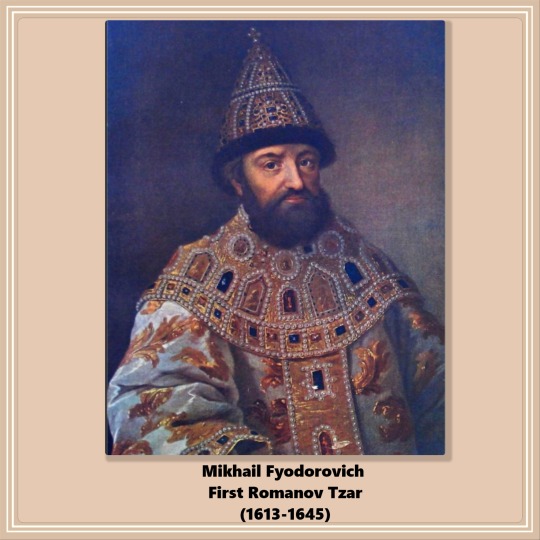






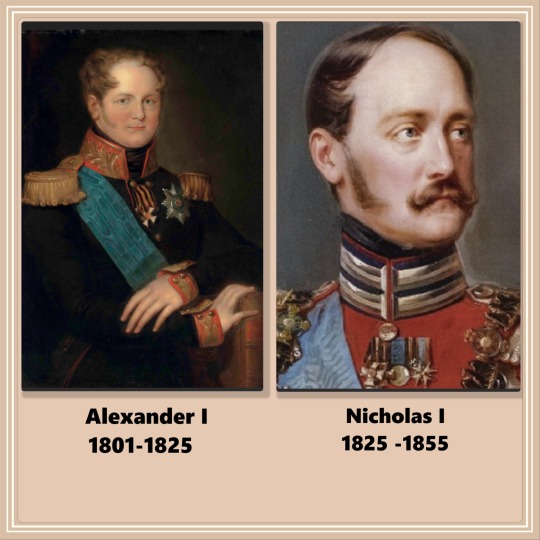

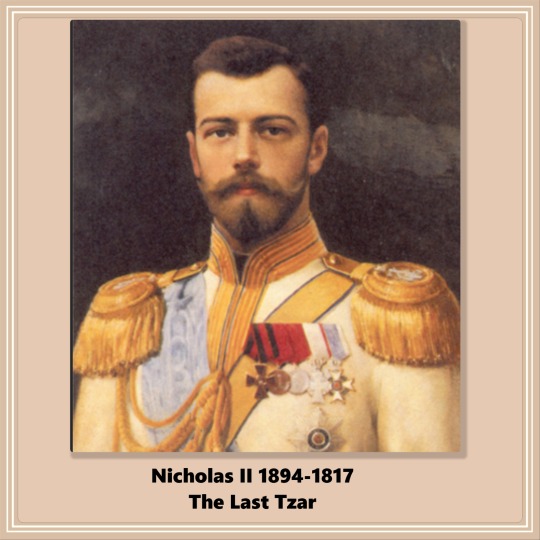
👑The Romanov Dynasty
The Grand Duchy of Moscow under Prince Ivan III was the first unified state on Russian territory. With him began the Rurikid Dynasty (the Rurikid had been around for a long time along hoards of tartars).
The Rurikid ruled from the 1400s until the 1600s. Ivan III can be considered the founder of Russia. While the Rurikid were in power, the Romanovs were boyars (nobles) in their courts. When the Ruriks became extinct, the Romanovs took over. The "Zemsky Sorbor" (a rudimentary parliament) elected Mikhail Feodorovich as the first Romanov Tzar.
The direct male line of the Romanovs ended with Elizabeth of Russia, who was childless. Her nephew Peter III, a member of the House of Holstein-Gottorp (a cadet branch of the German House of Oldenburg that reigned in Denmark), ascended to the throne and adopted his Romanov mother’s house name. Descendants after Elizabeth are sometimes referred to as "Holstein-Gottorp-Romanov."
The above is a gross oversimplification of a very complex course of events.
Highlights about each Romanov Tsar/Tsarina:
👑Mikhail Feodorovich (1613 - 1645): First Romanov Tsar
👑Alexei Mikhailovich (1645 - 1676): Encouraged trade and cooperation with Europe. Father of Peter the Great
👑Feodor III (1676 - 1682): Had very poor health and spent most of his reign in bed
👑Peter I and 👑 Ivan V (1689 - 1785): It was complicated. The two of them were Tsars under the regency of their older sister Sophia.
👑Peter I (1689-1725): Reformed Russia's politics, government, and culture. Made Russia a military power.
👑Catherine I (1725-1727): At the time of Peter the Great's death, the mechanism for succession consisted of the Tsar selecting his successor, but Peter did not elect one before dying. His wife became the Tsarina, but others governed through her.
👑Peter II (1727-1730): Peter's grandson; ascended the throne at 11 and died at 14. The "Privy Council" or "Soviet" ruled through him.
👑Anna Ioannovna (1730-1740): Daughter of Peter's half-brother Ivan. The Privy Council invited her to rule (wanting her to be a puppet), but she disbanded them and ruled herself successfully.
👑Ivan VI (1740-1741): One-year-old son of Ana's niece. She left the throne to him, expecting his mother to govern. Elizabeth, daughter of Peter the Great, deposed him (and his mother.)
👑Elizabeth Petrovna (1741-1761): Last Russian on the Russian throne; her twenty-year reign was successful.
👑Peter III (1761-1762): Grandson of Peter the Great and next in line for the throne after Elizabeth. Ruled for only half a year before being deposed by his wife, Catherine. He was murdered soon after the coup d’etat.
👑Catherine the Great (1762-1796): Her accomplishment went from the Empire’s territorial expansion to political development to the proliferation of sciences. However, the Empire had an enormous external debt by the end of her reign.
👑Paul I (1796-1801): Paul, the son of Catherine the Great and Peter III, became Emperor at 42 after the death of his mother. He started a lot of major military and political reforms. Paul was murdered in a coup d'etat. Paul decreed house laws for the Romanovs (the Pauline laws) – among the strictest in Europe – which established semi-Salic primogeniture and required Orthodox faith for the monarch and dynasts
👑Alexander I (1801-1825): During his reign, Russia defeated Napoleon's forces (which got as far as Moscow in their attempt to conquer Russia.) There was also great development in culture and arts.
👑Nicholas I (1825-1855): Paul I’s third son, younger brother of Alexander. Started railroad construction in Russia, boosting industrialization. Codified Russian laws and reformed finances.
👑Alexander II (1855-1881): His major reforms included the peasant emancipation of 1861, military reform, and the introduction of new types of self-governing village societies and more. Unfortunately, he fell victim to a terrorist after five attempts.
👑Alexander III (1881-1894): Russia didn’t enter any wars in his time. His domestic policy was conservative. He amended the Pauline laws. The economy flourished. But the revolution was brewing below the surface.
👑Nicholas II (1894-1917): His policies were unsuccessful. Established the first official Duma in 1905, but it was too little too late. With the advent of WWI, the Russian Empire ceased to exist. He abdicated. (gcl)
Sources:
Panov, A., Delaroche, P., & Abramuchkin, Y. (2021, July 31). The Complete List of Russian Tsars, Emperors, and Presidents. Russia Beyond. Retrieved June 20, 2023, from https://www.rbth.com/history/334065-complete-list-of-russian-tsars-emperors-rulers-presidents
#russian history#imperial russia#romanov dynasty#Nicholas II#Alexander III#Alexander II#Alexander I#Catherine I#Catherine II#Nicholas I#Paul III#Elizabeth Petrovna#Mikhail Feodorovich#Alexei Mikhailovich#Feodor III#Ivan VI#Peter I#Peter II#Peter III#Anna Ioannovna#Romanov Tsars#gcl
25 notes
·
View notes
Text
a little while ago I slapped myself on the forehead because I forgot to mention that it was the day of the death of Tsar Alexei Mikhailovich Romanov on 19th March...
#alexei mikhailovich#tsar alexei mikhailovich#imperial russia#russian#russian empire#romanovs#i love romanovsss
4 notes
·
View notes
Text



pyotr, stepan, and some sharillov in color
#demons dostoyevsky#demons#the possessed#Бесы#dostoyevsky#dostoevsky#fyodor dostoyevsky#fyodor dostoevsky#fyodor mikhailovich dostoevsky#Достоевский#pyotr stepanovich verkhovensky#pyotr verkhovensky#verkhovensky#alexei nilych kirillov#alexei kirillov#kirillov#ivan pavlovich shatov#ivan shatov#shatov#stepan trofimovich verkhovensky#stepan trofimovich#my art#q#lee.txt
87 notes
·
View notes
Note
First of all, I wanted to thank you for the interesting posts and photos you publish💋❤
My question is, did tsar Nicholas II ever meet his nephew George, son of grand duke Michael ?
or did OTMA ever meet their cousin?
Hello anon! Thank you for the compliments! I’m so glad you enjoy my blog!
So for a brief rundown of who this George person is, he was OTMAA’s uncle (and Nicky’s brother) Grand Duke Mikhail Alexandrovich’s son from his morganatic marriage to Countess Natalia Sergeyevna Brasova. Mikhail and Natalia cherished their young son and Mikhail and Georgy met several times before Misha was executed in 1918.



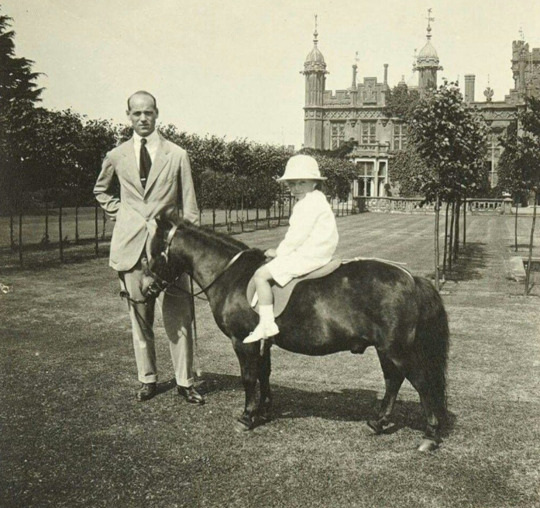

Georgy was born on July 24th 1910 when Olga was 14, Tatiana was 13, Maria was 11, Anastasia was 9, and Alexei was 5. Because Georgy was the product of a morganatic marriage, a marriage not getting approval from the monarch, and going against the laws of the Russian Orthodox Church, Nicholas most likely would not have allowed his children to meet their cousin.
Nicholas was a VERY faithful man and took morganatic marriages VERY seriously. He was very close to Misha and felt probably very betrayed by his actions. Because of this, Nicky would’ve not wanted to meet Georgy and would’ve kept his children away from him. I’m not 100% sure if they did happen to meet in the 7 years before they were killed. There is a chance though!
I think that @otmaaromanovas could go digging a lot more into if they ever possibly had met because she is a queen when it comes to letters and diaries!
Thank you for asking and sorry this took a long time to answer!
#answered ask#olga nikolaevna#tatiana nikolaevna#maria nikolaevna#anastasia nikolaevna#otma#alexei nikolaevich#otmaa#romanov#tsar nicholas ii#mikhail alexandrovich#Georgy Mikhailovich count Brasov#george mikhailovich#george Mikhailovich Brasov#georgy Mikhailovich brasov#natalia brasova
21 notes
·
View notes
Photo



Series: Postcards made up of other postcards.
#romanov#otma#nicholas ii#alexandra feodorovna#olga nikolaevna#tatiana nikolaevna#maria nikolaevna#anastasia nikolaevna#alexei nikolaevich#elizaveta feodorovna#georgy mikhailovich#my collection#my series
34 notes
·
View notes
Photo
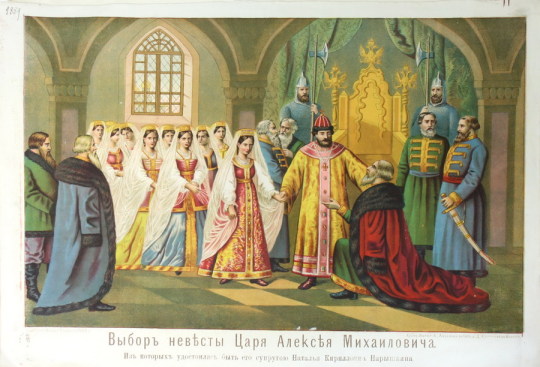
Tsar Alexey Mikhailovich choosing a wife. By Abramov.
18 notes
·
View notes
Text
105 years ago, on the night of 16/17 July 1918, the Romanov family and their attendants were killed in Ekaterinburg.
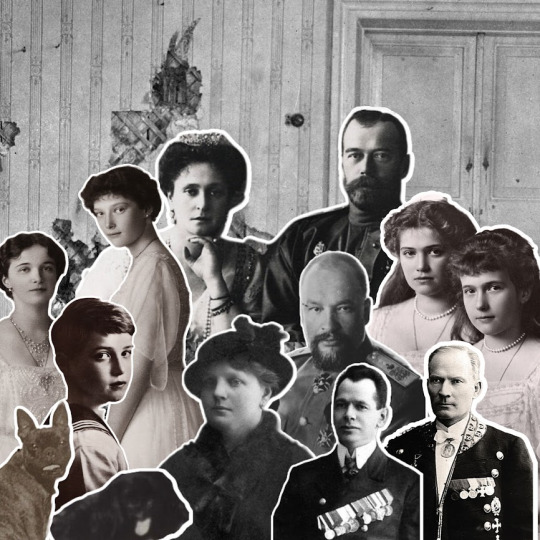
Pierre Gilliard, the beloved tutor of the imperial children, was one of the first people to enter the Ipatiev House after the murders. As part of the Sokolov Investigation into the crime and the subsequent media frenzy, he gave these statements:
“…the stoves; they were all full of various burned articles. I recognised a considerable number of burned things such as tooth- and hair-brushes, pins and a number of small things bearing the initials: "A. F." [Alexandra Feodorovna.]”
"I then went to the lower storey, the greater part of which was a basement. I entered with intense emotion the room in which, perhaps, they had died. Its aspect was most sinister. Daylight came in through a window with iron bars across it. The walls and the floor bore marks of bullets and bayonet thrusts. It was quite obvious that a dreadful crime had been committed there, and that several people had been killed.
In my despair believed that the Emperor had perished, and, that being the case, I could not believe the Empress had survived him… Yes, it was quite possible that they had both been killed. And the children? Had they also been massacred? I could not believe it. The idea was too horrible. And yet everything seemed to prove that the victims had been numerous."
Nicholas II Alexandrovich Romanov (1868-1918)
Alexandra Feodorovna Romanova (1872-1918)
Olga Nikolaevna Romanova (1895-1918)
Tatiana Nikolaevna Romanova (1897-1918)
Maria Nikolaevna Romanova (1899-1918)
Anastasia Nikolaevna Romanova (1901-1918)
Alexei Nikolaevich Romanov (1904-1918)
Dr. Evgeny Sergeievich Botkin (1865-1918)
Anna Stepanova Demidova (1878-1918)
Ivan Mikhailovich Kharitonov (1872-1918)
Alexei Aloise Egorovich Trupp (1856-1918)
Ortipo (1914-1918)
Jimmy (1915-1918)
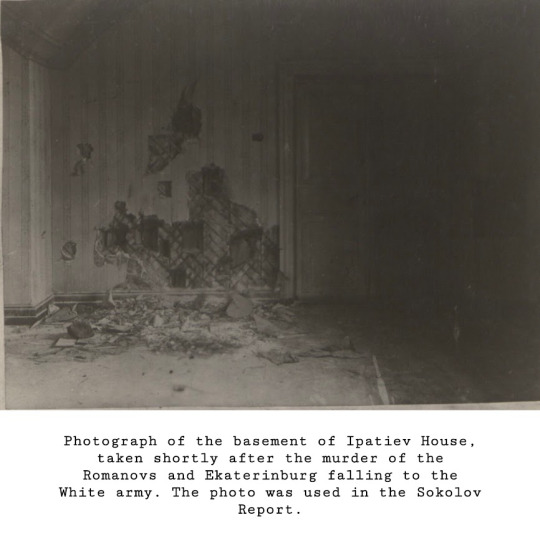









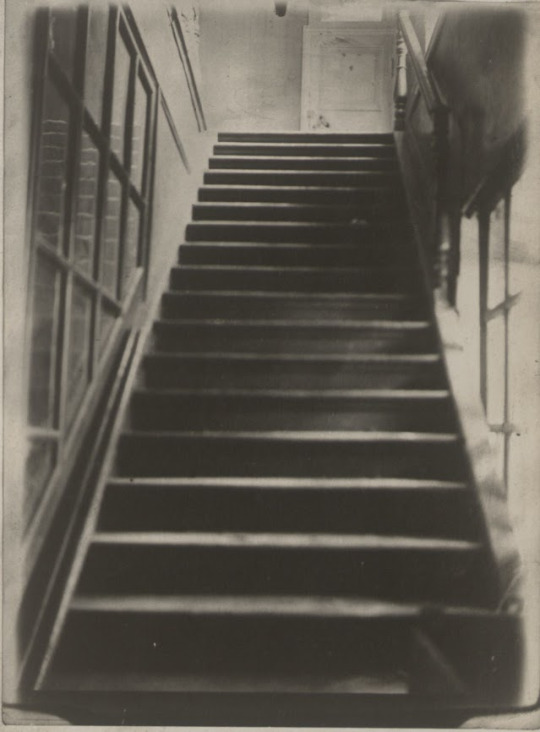
SOURCES:
The Last Days of the Romanovs, Telberg, Wilton, Sokolov. The Crime of Ekaterinburg, Illustrated London News
#olga nikolaevna#tatiana nikolaevna#maria nikolaevna#anastasia nikolaevna#alexei nikolaevich#Tsar Nicholas II#Alexandra Feodorovna#Alexei Trupp#Aloise Trupp#Anna Demidova#Dr. Botkin#Evgeny Botkin#Ivan Kharitonov#Jimmy#Ortipo#OTMA#NAOTMAA#Romanov family#Russian history#imperial russia#Ipatiev House#Ekaterinburg#Nikolai Sokolov#Sokolov Report#sources#Pierre Gilliard#my own
103 notes
·
View notes
Text
Semifinals, Match 1
It's just... So fucking poetic that one of the most reactionary tsars (yes, even by the standards of 17th century Russia) goes toe-to-toe with one of the most progressive ones (well, by the standards of 19th century Russia anyway, like this dude's immediate predecessor and successor were Nikolai I. and Alexander III.).
WHAT THEY LOOK LIKE ON A HORSE
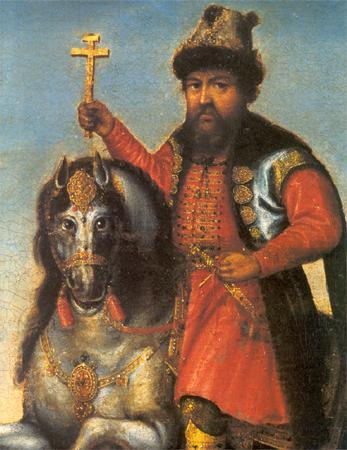
Did I make the horse portraits the theme of this round just to show off this masterpiece? Well, I am not NOT saying that... Anyway, Alexei I. Mikhailovich everyone.
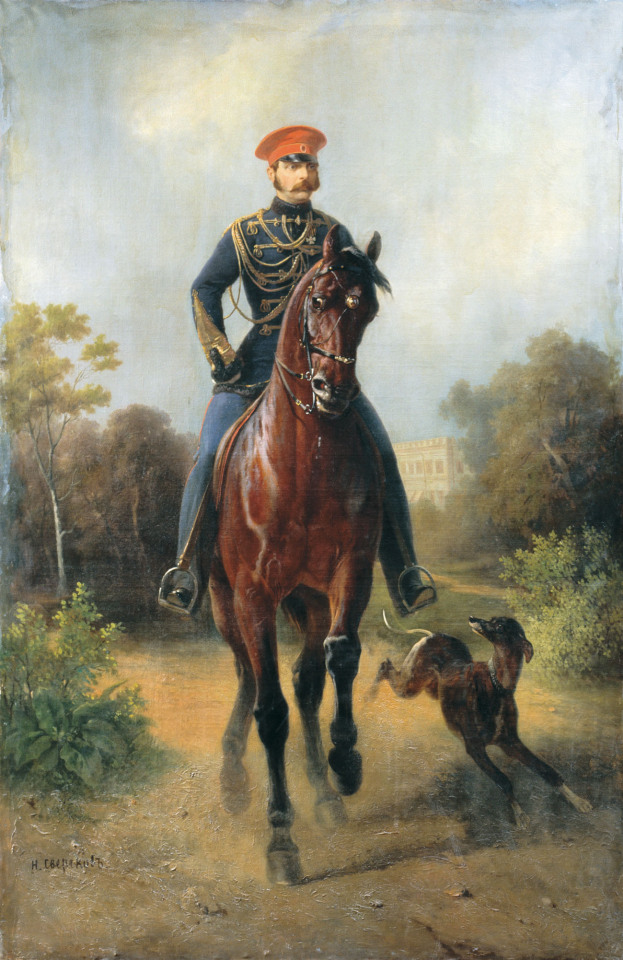
Our verdict: Alexander II. Nikolaevich looks good on a horse! His face is just far enough that you cannot see his dumb moustache!
***
9 notes
·
View notes
Text
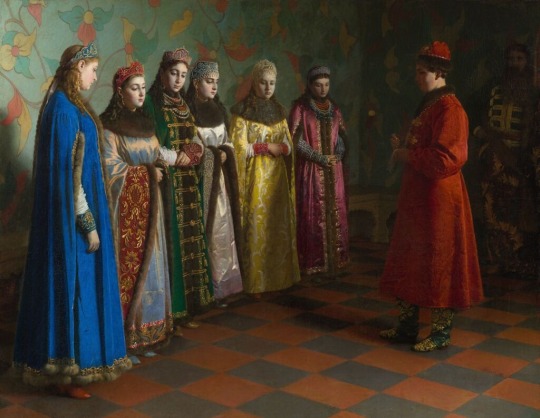
Grigory Sedov (1836-1884)
TSAR ALEXEI MIKHAILOVICH CHOOSES A BRIDE
1882
Material - canvas
Technique - oil
Tretyakov Gallery
19 notes
·
View notes
Text

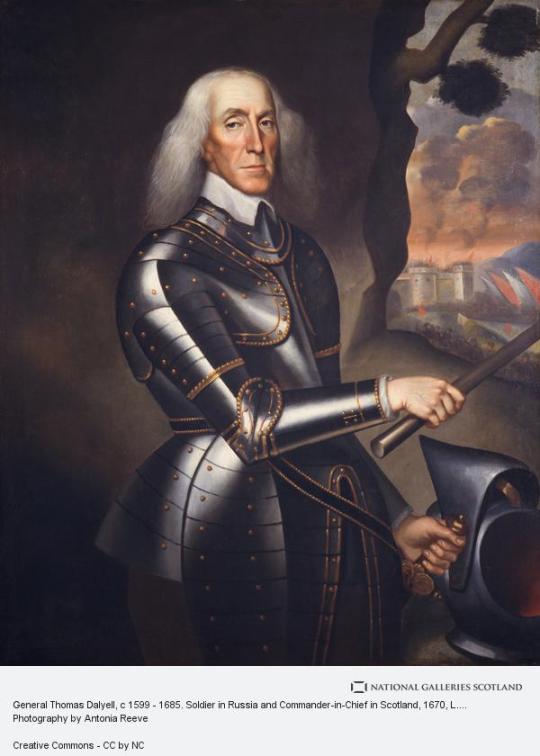

November 25th 1681 General Tam Dalyell raised a regiment to suppress Covenanters which later became the Royal Scots Greys.
Also known as Bluidy Tam, General Dalyell, became notorious for his suppression of the Covenanters at the Battle of Rullion Green, in the Pentland Hills, in 1666. Little more than a thousand Protestant 'rebels' had marched from Dumfries towards Edinburgh, armed only with scythes, pitchforks and staves. Tam is said to have been disgusted with his soldiers after they killed men women and children, and resigned his commission.
Earlier in his life, while fighting for Charles I in the civil war he had been imprisoned after Oliver Cromwell won the Battle of Worcester. He managed to escape from the Tower of London and fled to Russia where he achieved high rank in the army of Tsar Alexei Mikhailovich, father of Peter the Great in Russia and is said to have brought back a rather nasty invention back to Scotland with him, the dreaded thumbscrews. It was his time there that gained him the other unenviable nickname "Muscovite De'il", where he also noted while in Russia that it was much more difficult to spot Russian soldiers than traditional "British Red Coats". Therefore he also brought back the stipulation that the Scots Greys wore grey uniforms as camouflage, which was successfully used against the Covenanters. He had also raised a regiment of infantry in 1666, but no records of the foot regiment exist today.
Another interesting legend about the man is connected with a Marble topped card table that it is said during a particularly fraught card match played between the General and the devil was thrown at Dalyell , but missed and ended going out the window, landing in a nearby pond, a marble table was indeed found when the pond dried up 200 years later. The cards, goblet and spoon, supposedly used in the game are displayed in the house. The General is said to have told the Devil, who threatened to blow down his house and its walls, that "I will build me a turret at every corner to pin down my walls".
In August 1685 Lieutenant-General Tam Dalyell died at his town house just off John Street in the burgh of the Canongate where he lived with his fourth wife Marion Abercrombie. But the story didn't end there.......
Following military tradition his boots were hung in reverse from the saddle of his horse while his martial baton was carried on the top of the coffin. Troopers of the Royal Scots Dragoons, the red-coated Scots Guards and six field guns escorted his funeral procession. Watched by hundreds of citizens, who lined the route, the sombre military procession with muffled drums beating wound its way slowly up the hill through Portsburgh leaving the city by the west gate, now known as West Port.
"Old Tom of Muscovy" as he had been nick named by King Charles II was buried beside his parents in the family vault at Abercorn Church not far from the ancestral home, The Binns. Tam's third son John took his father's cavalry boots back to his home at Lingo in Fife but he was forced to return them to The Binns. Every night when he took them off they awakened the sleeping household as they marched around the house. It was said that if cold water was poured into them, it would quickly come to a boil!!!
Although he was long gone, Tam's legend continues to grow. On pitch black nights the General mounted on a white charger could be seen entering his estate by the Black Lodge situated on the road between Bo' ness and Queensferry. Clattering across the ruined bridge over the Errack Burn, the ghostly horse and rider would gallop up the old road to the Binns.
The third pic is called Scotland Forever and is a depiction of the Scot's Greys leading the charge at the Battle of Waterloo.
7 notes
·
View notes
Text

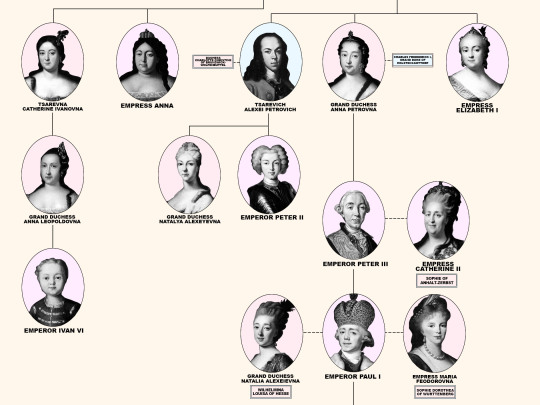
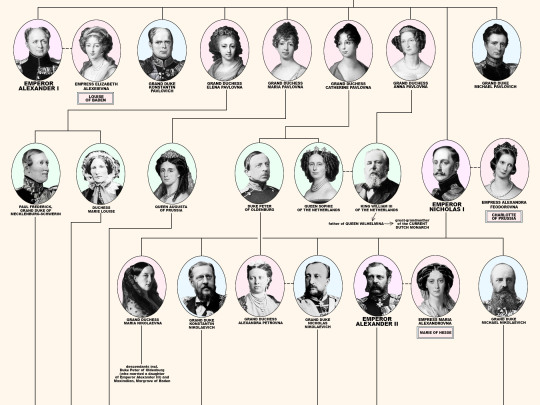
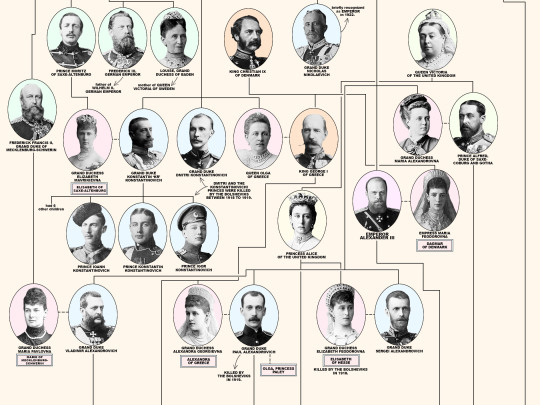

Members of the House of Romanov, the last reigning Dynasty of Russia.
From the first Romanov Russian Tsar Michael I (reigned 1613-1645) until the last Emperor Nicholas II (reigned 1894-1917). Including the 18 members of the house executed from 1918 until 1919; Grand Duke Michael Alexandrovich (13 June 1918). Nicholas II, Empress Alexandra Feodorovna, Grand Duchesses Olga Nikolaevna, Tatiana Nikolaevna, Maria Nikolaevna, Anastasia Nikolaevna, and Tsarevich Alexei Nikolaevich (17 July 1918). Grand Duchess Elizabeth Feodorovna, Grand Duke Sergei Mikhailovich, Prince Ioann Konstantinovich, Prince Konstantin Konstantinovich, Prince Igor Konstantinovich, and Prince Vladimir Paley (18 July 1918). Grand Duke Paul Alexandrovich, Grand Duke Dmitri Konstantinovich, Grand Duke Nicholas Mikhailovich, and Grand Duke George Mikhailovich (28 January 1919).
#romanovs#history#nicholas ii#alexandra feodorovna#olga nikolaevna#tatiana nikolaevna#maria nikolaevna#anastasia nikolaevna#alexei nikolaevich#myedits#peter i#peter ii#Peter iii#peter iii#Catherine the great#tsar alexei i#tsar michael#tsar paul i#alexander i#alexander ii#alexander iii#nicholas i#ancestry
342 notes
·
View notes
Text
"In St. Petersburg we work, but at Livadia, we live."
Grand Duchess Olga Alexandrovna
In 1909, Nikolay Krasnov, who was responsible for the Yousupoff Palace in Koreiz, was engaged to design a new imperial palace in Livadia (before that, there had been an imperial residence in Livadia consisting of a large and a small palace used by Alexander II and later by Alexander III, who died at the smaller residence.) When Nicholas II decided to build the new palace, he also demolished the older residence but left the small palace where his father died.
The Tsar's diary indicates that the Imperial Family discussed the design; it was decided that all four façades of the palace should look different. After 17 months of construction, the new palace was inaugurated on 11 September 1911. In November, Grand Duchess Olga Nikolaevna celebrated her 16th birthday at Livadia.
The family was always the happiest at Livadia.
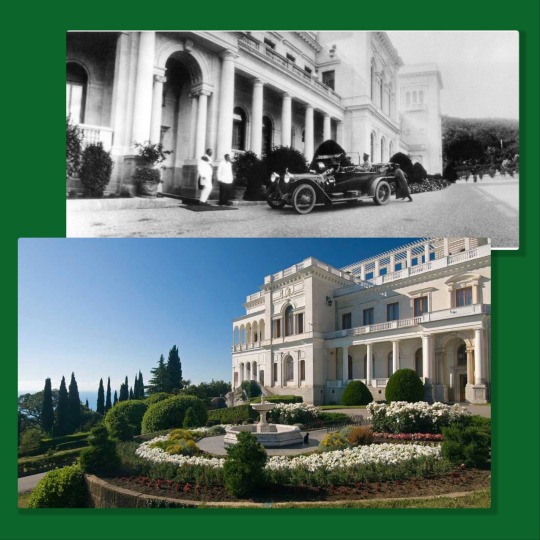
One of the Tsar's "motors" at Livadia. If you look carefully, you can see the "side of the palace" where the car is parked and the main entrance in both the contemporary colored and black and white photos.
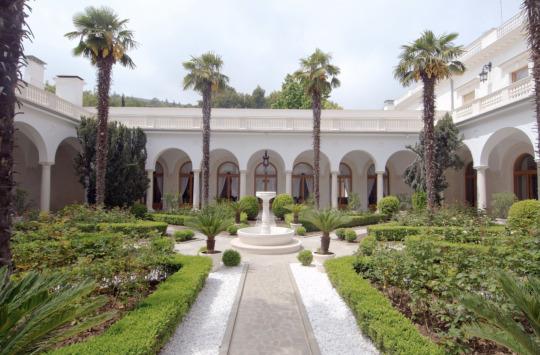
Above is the beautiful Italian Courtyard of the palace as it stands today. If you look at pictures taken when the Romanovs used the palace, the centerpiece of the courtyard was different. Today, there is a fountain at the center. Examining the older pictures (below), you can see that there seemed to be what I can only describe as a "well" at the center of the courtyard. There was a column on each side of the well. In one of the photos below, you can see Grand Duke Dmitry Pavlovich; he had his own rooms at the Livadia Palace.
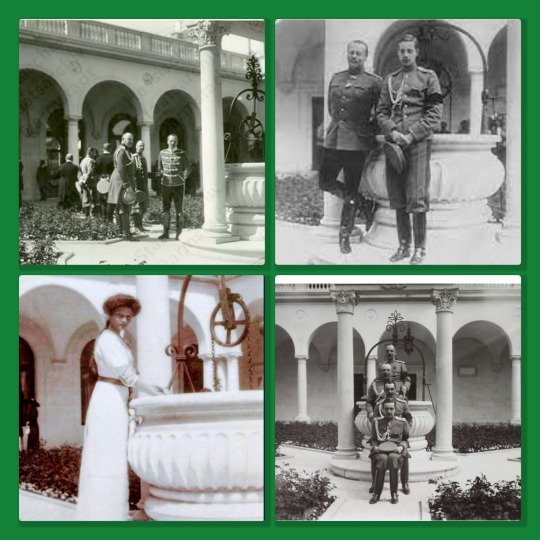
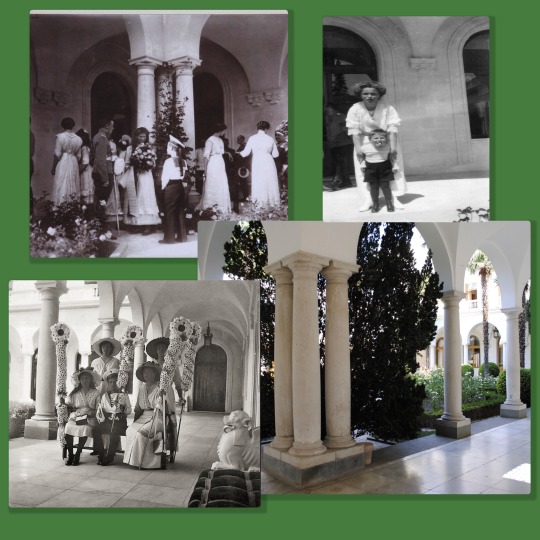
Nicholas II and his family were so at ease at Livadia that they also conducted some minor official functions in addition to family activities. When the family went to Livadia, they usually went as far as Yalta by sea; it is easy to infer that the official activities they conducted were related to the crew of the Standart. In addition, at the time, it was believed that mountain air and rest could cure tuberculosis, and there were several spas and sanatoria in the mountains in the area. The Empress and the girls visited the sick there (they also participated in other charitable activities.)



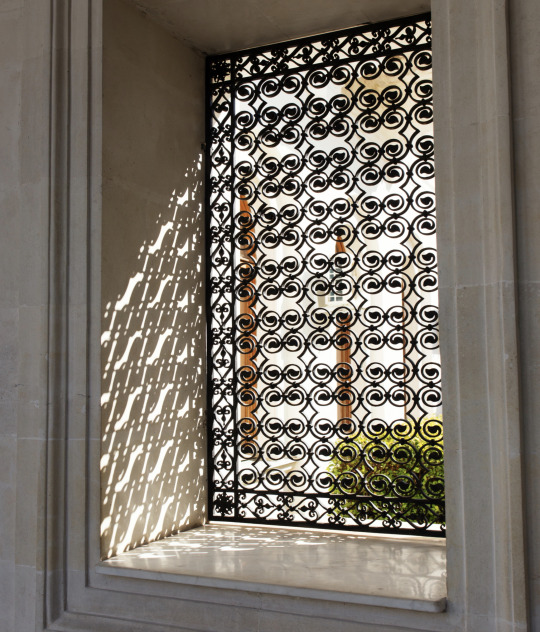
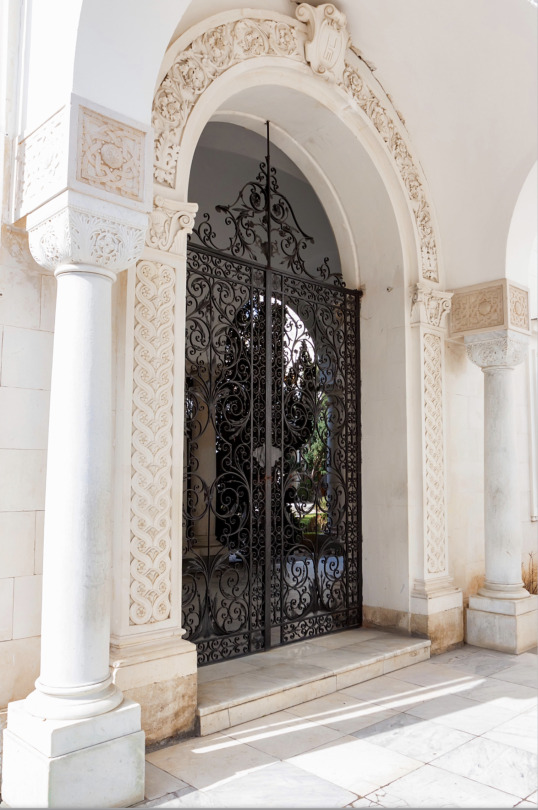
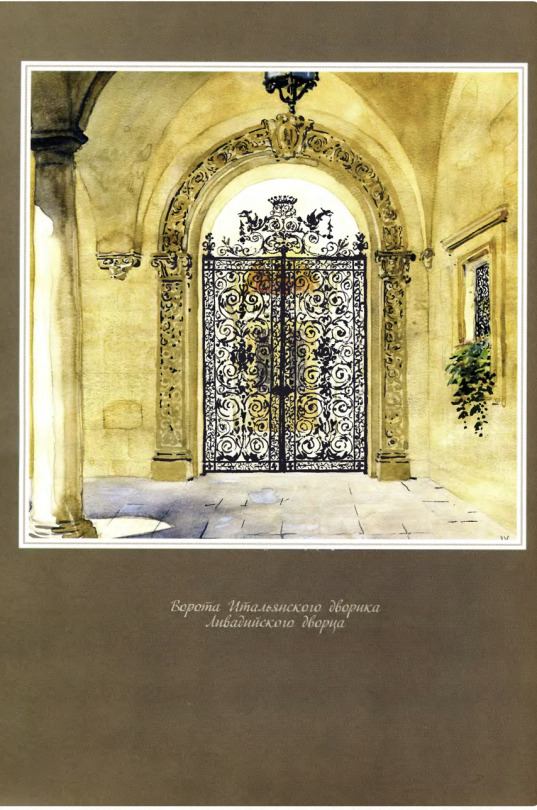
The Yousupov family gifted the beautiful door above to Nicholas and Alexandra. The painting next to it is from a beautiful book by Kravnov ("Fiftieth Anniversary of Yalta"), who worked on the palace's design (and on that of the Crimean summer residences of several Grand Dukes.) The window is also featured in the painting.
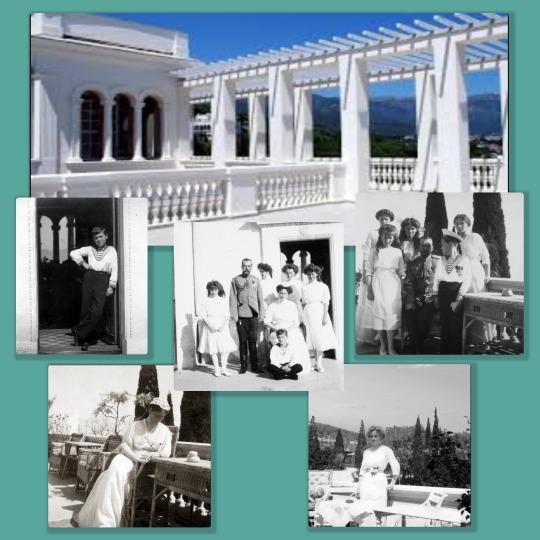
The "solarium" seems to have been a very popular area. Nicholas and his children preferred the outdoors, and Livadia seemed to provide the Empress with the perfect environment to get sun and fresh air in comfort regardless of her many ailments.

This is the "Moorish" courtyard of the palace. It is small, but notice the exquisite tilework on the walls. And, of course, the little balcony between the windows seemed perfect to Alexis for him to "address" his family.
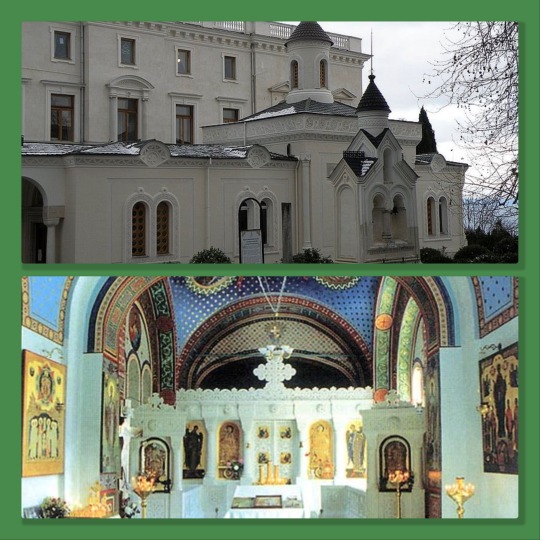
The palace had a chapel so that the Romanov family could worship in privacy.
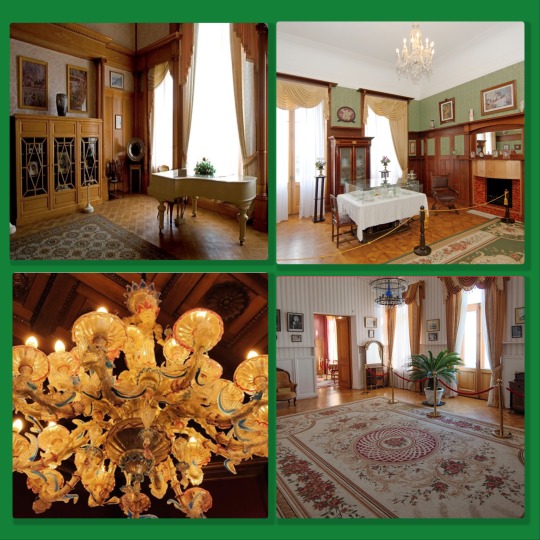

A few of the interiors of the palace. The chandelier is Murano Glass (amazing that it survived all these years.) Olga's coming-of-age celebration took place in Livadia in the formal dining room in the photograph above, dancing spilling into the flower-perfumed courtyard. That is a luxury of the type you cannot buy! The girls' rooms are currently being restored. There are pictures of the rooms as they were, but I was not sure they were from Livadia, so I did not include them.
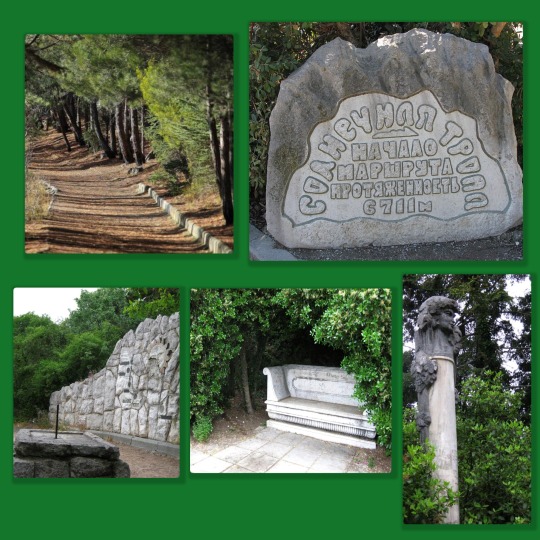

Finally, some photos of the "Tsar's Path" (or Sunny Path), which exists to this day (it goes from Livadia Park to the city of Gaspra.) The family loved to walk this path (regardless of its name, it is not sunny but pleasantly breezy). This path is on one level so that anybody can walk it, regardless of their cardiovascular status. I have read two stories about how it "emerged," and as usual, the truth is probably in the middle. First story: The new Livadia Palace did not exist yet, but the Romanovs used the old palace and always loved coming to Livadia. Alexander III kept gaining weight, and his doctor recommended that he walk but not overdo it...so Alexander had the path leveled. The path's beginning and end differed from what they would be later. Second Story: Sandro had the path from Ay Todor toward Livadia built because Nicholas and Sandro's families always visited each other (they started calling it the Prince's Path.) Nicholas loved the idea and extended the path.
Today, the main path remains, and other routes to other small towns can be hiked from it. Many of the same benches and sculptures are where they were at the time of the Romanovs.

Just one last photo. Here, you can see how close the palace is to the mountains and the sea. A beautiful big house full of fresh air and light with flowers perfuming the air. No wonder Olga liked it so much! (gcl)
#russian history#romanov dynasty#nicholas ii#otma#Empress Alexandra Feodorovna#Emperor Alexander III#Grand Duke Alexander Mikhailovich#Ay Todor#Nikolay Krasnov#grand duchess olga nicholayevna#Grand Duchess Tatiana Nicholayevna#Grand Duchess Maria Nicholayevna#Grand Duchess Anastasia Nicholayevna#Tsarevich Alexei
57 notes
·
View notes
Text
About the Ilyin-Chernigov and Chernigov-Gethsemane icons of the Mother of God.
Commemoration:
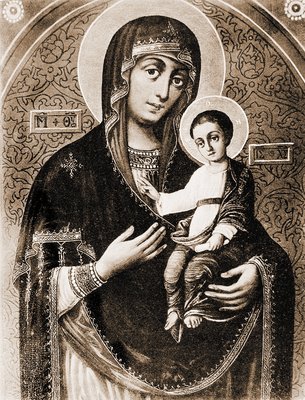
CHERNOGOV-GETHSEMANE ICON
april 16_april 29
Many healings of mental illness and demonic possession happened from the Chernihiv icon. St. Ambrose of Optina suggests in one letter that a mad person be brought to this icon.
The Ilyin-Chernigov Icon of the Mother of God was painted in the year 1658 by the iconographer Gregory Dubensky, (Gennadius in monasticism). Tears flowed from the icon for eight days in 1662, from April 16-24.
In this same year, Tatars descended upon Chernigov and devastated it. At midnight, they burst into the Trinity monastery, entered the church, overturned all the icons, and grabbed all the utensils, but the wonderworking icon and its ornaments remained untouched.
An invisible power held back the impious from the holy icon. Previously, the Queen of Heaven had not permitted the enemy to enter the cave of St Anthony of the Caves, where the monastery's brethren had hidden. The Tatars fled, as though terrified by a vision.
The miracle of the Mother of God and Her Chernigov Icon was described by St Demetrius of Rostov (October 28 and September 21) in his book, THE BEDEWED FLEECE [Runo Oroshennoe]. Later on, St John of Tobolsk (June 10) also wrote about the Chernigov Icon.
A wonderworking copy of the Chernigov Icon of the Mother of God, in the Gethsemane skete of the Trinity-Sergiev Lavra, was glorified in the year 1869 (September 1).
24 miracles (by the number of hours in a day) from Ilyin-Chernigov icon of the Mother of God (based on the book of Saint Dimitry of Rostov “The bedewed fleece”).
Miracle 1.
In the reign of the Great Sovereign Tsar and Grand Duke Alexei Mikhailovich, Autocrat of All the Great and Small and White Russia, when the archbishop throne in Chernigov was held by the Right Reverend Father Lazarus Baranovich, the Orthodox Archbishop of Chernigov, Novgorod, and the entire North, in the year 1662 Anno Domini, in the month of April, in the monastery of Elijah the Prophet (the Ilyin monastery), under the hegumen Zosima, from the 16th day to the 24th, the icon of the Immaculate Blessed Virgin Mary was weeping in the church. All the people of the city of Chernigov watched this miracle with great horror.
Miracle 2.
Also, in 1662, when the icon of the Mother of God was weeping, the Saracens (Muslims), by God's allowance for our sins, quietly crept up and captured many villages in the neighborhood of Chernigov. The monks of that Ilyin monastery, unaware of the barbarian invasion, sat in their monastery, and one night, it was announced about the Tartars. Then they all went to the church and hid in the cave of our Saint Father Anthony.
At midnight, the Tatars attacked the monastery and broke into the church, where there was a miracle-working icon of the Most Holy Mother of God, decorated with silver plates, according to the custom. The godless committed a lot of blasphemies: they threw down all the icons from their places to the ground, took all churchware...
But they did not touch the icon of the Mother of God, which was standing at the local place of the iconostasis, nor did they touch the silver plates on it. Possibly as once for Prophet Elisha, so here the Lord God smote the heathens with blindness, so that being blind with their spiritual eyes, they would not sight with the bodily eyes either at the icon of the Mother of God, which we, looking at, see as the true Mother of God.
The power of God forbade them: let they not touch the Mental Kiot with unworthy hands.
The heathens not only did not touch the icon but also could not enter the cave where the monks were hiding, even though they attempted to do so many times with lit splinters and drawn swords. However, they, being driven away, returned as if thrown back by someone. The Immaculate Virgin's power, protecting the monks, prevented the Saracens from entering the cave.
Miracle 3 in 1667.
One woman named Vera (what means Faith - translator's note) from Mozirsk county (uyezd) was paralyzed for a whole year. Being dumb, she had a withered hand as well. Having reached the Ilyin monastery on Saturday, the eve of Pentecost, the woman was healed during the singing of the Akathist before the miraculous icon of the Most Holy Mother of God. First, she moved the withered and motionless hand, showing it to all stretched out her hand, and it was restored as whole as the other. Then, during the liturgy, at "It is truly meet," she spoke with the silent tongue - and cried, thanking the Most Blessed Virgin for the sudden healing.
Miracle 4 in 1671.
Someone of the nobles named Penskiy, from the outskirts of Bragin, had a wife, Anna. For several years, she had severe pain in her legs; she had to be carried; she could not make a single step herself. Doctors who treated the incurable disease have already become exhausted.
The man heard about the miraculous icon of the Most Holy Mother of God that was in the Ilyin monastery and brought his wife there. She was carried to the church, and here, having prayed warmly with tears, she received a quick healing: she got up on her feet at once.
As the lame in Jerusalem described in Acts (Acts 3, 3), this wife also had her feet and ankles strong again, and she jumped up, praising God and the Mother of God. Everyone was filled with amazement at what had happened to her.
Miracle 5 in 1672, ( commemoration in April)
Some nun named Alexandra of the convent of the Holy Martyr Paraskeva in Chernihiv has long suffered from demonic delusion: many times, terrible images appeared to her, rushing to her, seeking to kidnap her, forbidding her to pray. She endured all this with great fear, horror, and dread; sometimes, she screamed with fear and cried so that people being with her were terrified and trembled. Finally, when she was exhausted with so many fears and was only waiting for death, she was brought by the nuns to the Ilyin monastery, to the miraculous icon of the Most Holy Mother of God, for the Saturday Akathist. Here, by the grace of Our Lady Intercessor, all dreams, apparitions, and fears left her, and she returned, having the help of the Mother of God against the entire enemy's force, which no longer could cause her such suffering.
Miracle 6 in 1672.
One man named Lavrentiy, a resident of Chernihiv, got mad and, as is commonly the case with such people, ran around the town and the field at night. One day, he wanted to drown in the river, but he was captured and brought to the miraculous icon in the Ilyin monastery. During the monks' prayer for him, the grace of the Mother of God gave him intellect, sense, and reason.
So, being healthy and sane, he returned home, praising the Mother of God Who brought him to reason.
Miracle 7.
Andrey Rachkevich, captain of the army of his Imperial Majesty, lived in Chernigov castle with his wife of the Roman faith.
His daughter was in shrouds because of grave illness, she was dumb and blind, her eyes were covered with scabs and swelled up with pus... Her father and mother, weeping, brought her, close to death, with faith to the Ilyin monastery and put her before the miraculous icon of the Most Holy Mother of God, warmly praying for the healing of their daughter.
The Akathist to the Mother of God was read as usual; it was Saturday. And so, at the reading, that girl shrouded began letting out a plaintive voice and, having freed the hands from the shrouds, began to wipe her eyes.
Parents rejoiced and, having lifted their daughter off the ground, found that scales of scabs fell away from the eyes, and the child became healthy all over. Seeing this, everyone who happened to be there gave glory to God and the Mother of God...Continue reading the list of miracles
2 notes
·
View notes
Text

kirillov :(
#demons dostoyevsky#demons#the possessed#Бесы#dostoyevsky#dostoevsky#fyodor dostoyevsky#fyodor dostoevsky#fyodor mikhailovich dostoevsky#Достоевский#alexei nilych kirillov#alexei kirillov#kirillov#my art
59 notes
·
View notes
Text
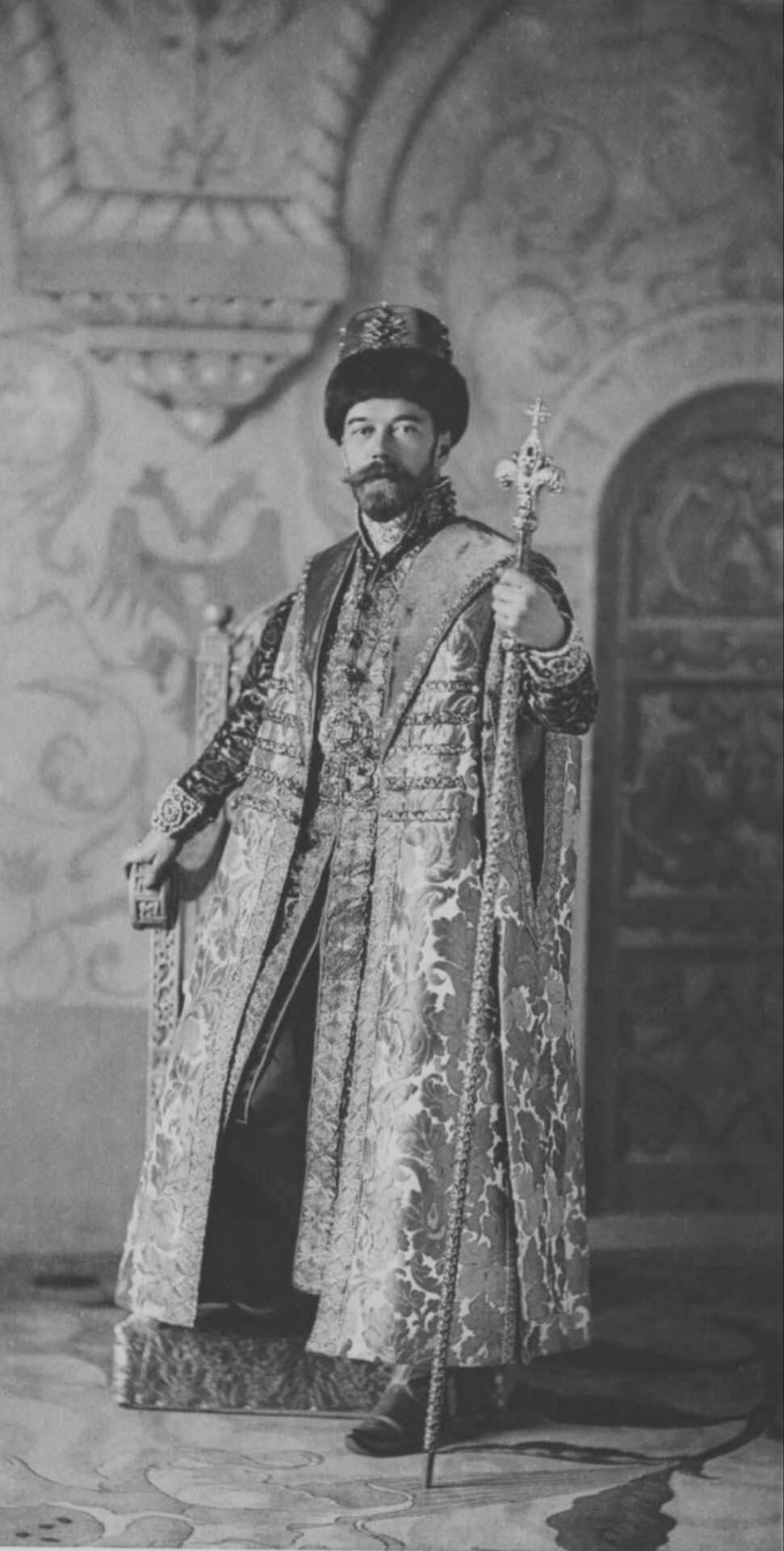
His Imperial Majesty Tsar Nikolai Alexandrovich (in the clothes of Tsar Alexei Mikhailovich), 1903. Album of the costume ball at the Winter Palace.
3 notes
·
View notes